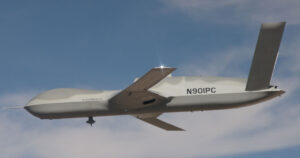General Atomics’ Aeronautical Systems, Inc. (GA-ASI) conducted a completely autonomous flight test using an artificial intelligence (AI) pilot on an MQ-20A Avenger unmanned aircraft system (UAS) on Sept. 12, the company said this week.
The company said it used internal research and development funding with the aircraft it owns with the AI pilot operating for almost 30 minutes as part of a “cooperative live, virtual, and constructive UAS swarm.”

The company did not disclose how much internal funding was used in this test flight.
GA-ASI boasted it conducted the flight as part of the company’s commitment and investment in the development of advanced autonomy of AI and Machine Learning for UAS. It added the aircraft used an “operationally relevant, Open Mission Systems (OMS) software stack.”
The company said its flight test used its Reinforcement Learning (RL) architecture to develop and validate an RL agent in an operational relevant environment.
“RL agents provide a new and innovative tool for next-generation military platforms to make decisions under dynamic and uncertain real-world condition,” GA-ASI said in a statement.
The GA-ASI team specifically flew “chase and avoid behavior” with real-time updates made to the flight path to avoid adversaries using live fused tracks. GA partnered with Lockheed Martin [LMT] to let live tracks to be sent to the system via its Infrared Search and Track (IRST) sensor network.
The IRST sensor network specifically comes from Lockheed Martin’s TacIRST multifunction embeddable sensor system with an open architecture, which it said aims to provide capabilities for both crewed and uncrewed aircraft.
“We anticipated the need for passive, long-range threat detection by autonomous aircraft and are proud to see this capability integrated successfully on the Avenger,” Terry Hoehn, Director of Lockheed Martin’s Advanced Threat Warning Systems, said in a statement.
Hoehn said the company hopes for more collaboration and testing with GA-ASI.
“The flight was a tremendous success and demonstrated a number of groundbreaking capabilities in the race to operationalize autonomy for Collaborative Combat Aircraft (CCA). It’s exciting to see how AI can be used to advance how and where we fly unmanned systems as the complexity of the battlespace increases,” said GA-ASI Senior Director of Advanced Programs Michael Atwood.
Atwood added that this chase and avoid ability that allows them to update the flight path as threats were found “is the first step toward building an ecosystem of collaborative autonomous combat aircraft.”
GA-ASI underscored the test team used a government-furnished CODE autonomy engine with the government-standard OMS messaging protocol to allow the RL agent and Tactical IRST to communicate.
By using these standards, “rapid integration of autonomy for collaborative combat aircraft becomes possible,” the company said.
The flight test also used technologies from General Dynamics’ Mission Systems [GD], with the computer hosting the OMS software part of GD’s Digital Backbone Node (DBN) family of systems.
GA-ASI argued the DBN architecture allows rapid and secure deployment of “evolving capabilities needed for CCA through application of the latest government open architectures, high-performance computing, advanced cooling, and a high-speed backplane with multi-level security to maximize battlefield collaboration between platforms.”
The company previously pitched the MQ-20 Avenger aircraft, formerly called the Predator C, as an option for the Navy’s former Unmanned Carrier-launched Airborne Surveillance and Strike (UCLASS) program, dubbed Sea Avenger.
When the Navy shifted from UCLASS to an aircraft carrier-based tanker, GA participated in the MQ-25 Stingray competition, bidding with an aircraft similar to the MQ-20 Sea Avenger, but larger. The Navy ultimately chose Boeing’s [BA] design for the MQ-25A tanker.